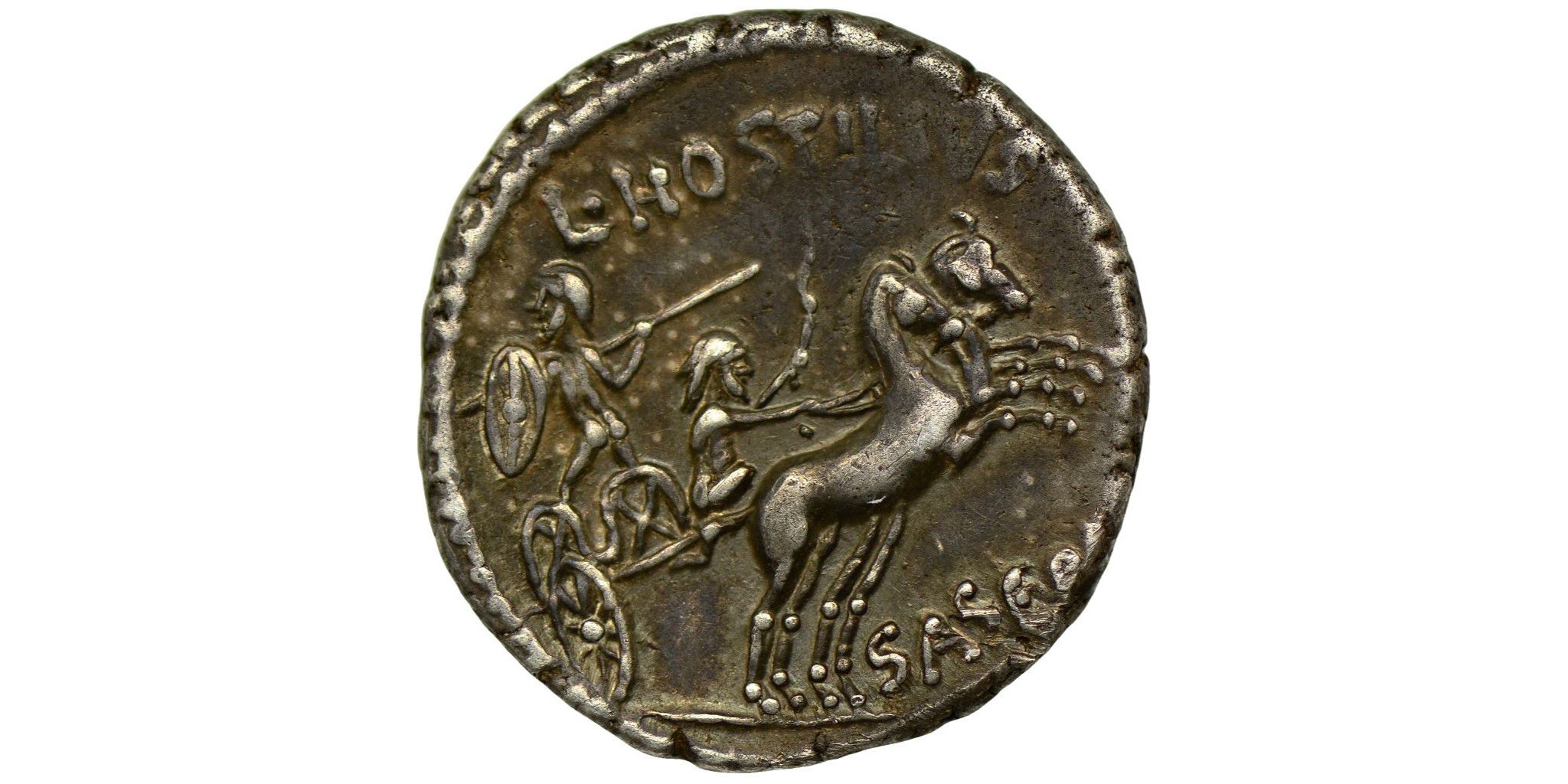£4,750.00
A delightful and enduring coin and a very desirable type among collectors.
Sold - Jun 23
L. Hostilius Saserna (48 BC), Roman silver Denarius, Rome mint. Obv. Bare head of Gallic captive warrior, Vercingetorix (?), facing right with long flowing hair and pointed beard, Gallic shield behind. Rev. Two warriors in galloping biga facing right, one driving holding reins and whip, the other facing backwards brandishing a shield and spear, L HOSTILIVS above, SASERN below. 3.90g, die axis 5h (Sear 418 (RCV I); Crawford 448/2a; Sydenham 952). A delightful and enduring coin with much eye appeal, centrally struck with a light grey tone, a very desirable type among collectors. Good very fine and scarce.
With old ticket.
By James Withers, numismatist, specialist in Celtic and Roman coinage at Asprey Coins
Descending from the third king of Rome Tullus Hostilius, Lucius Hostilius Saserna was from the Gens Hostilii. The denarius on offer here was issued by Lucius in 48 B.C. with early opinions that the male bust likely represented Pavor, the god of panic/terror. King Tullus Hostilius constructed a temple to Pavor during his victory over the Etruscans, so the idea has some merit. It was, of course, very much the norm for moneyers of the republic to allude to their proud ancestry in this way.
More recently the bust shown on this coin has been associated with the famous Arverni Chieftain – Vercingetorix. Vercingetorix is somewhat of a folk hero in France due to successfully uniting the tribes of Gaul against Caesar, winning a decisive battle at Gergovia before eventually surrendering himself at the Siege of Alesia. This coin was struck whilst he was captive in Rome before Caesars Triumph in 46 B.C. where he was paraded through the streets before his execution.
It is my opinion, along with many other scholars I’m sure, that the iconography of the coin on offer is clearly a celebration of Caesar’s Gallic victory. The flowing locks, long moustache and beard, the Gallic shield behind his bust and the reverse depicting naked warriors on a chariot can surely leave no doubt of that. The imagery is very similar to that found on Caesar’s own issues. RRC 452/4 for example shows a remarkably similar bearded male at the base of a trophy then RRC 468/1 again shows a bearded male and also a mourning female at the trophy base. What is odd about this issue however, is it doesn’t show a Gaul enslaved, in-fact there almost appears an element of reverence which may add some weight to the Vercingetorix argument. On the contrary it is curious that Caesar himself mentions in his Commentarii De Bello Gallico that only the British Celts still fought with war chariots, this contradicting the naked warrior on chariot imagery on the reverse of this coin and perhaps points to both the obverse and reverse being more than just a generic, stereotypical depiction that the roman populace would easily understand.
Ultimately we can only speculate and we will likely never be able to say for sure if the figure on this coin is indeed Vercingetorix himself but either way, this historic issue will no doubt continue to intrigue and cause debate. The coin on offer is well centred and has a very pleasant, deep old collection tone. The obverse in particular is extremely artistic and you can almost see the despair in his eyes. A highly desirable and much collected type, this coin should appeal to anyone with an interest in Roman history, republican coinage and also probably those with an interest in Celtic history and culture.
Tip: Click on any ‘gold’ attribute below to find ALL items for sale with that same matching attribute!
| Country | |
|---|---|
| Period | |
| Ruler | |
| Date | |
| Metal | |
| Denomination | |
| Condition | |
| Mint | |
| Weight | |
| References | Sear 418 (RCV I); Crawford 448/2a; Sydenham 952 |
| Rarity | Scarce |
| Old Ticket |







